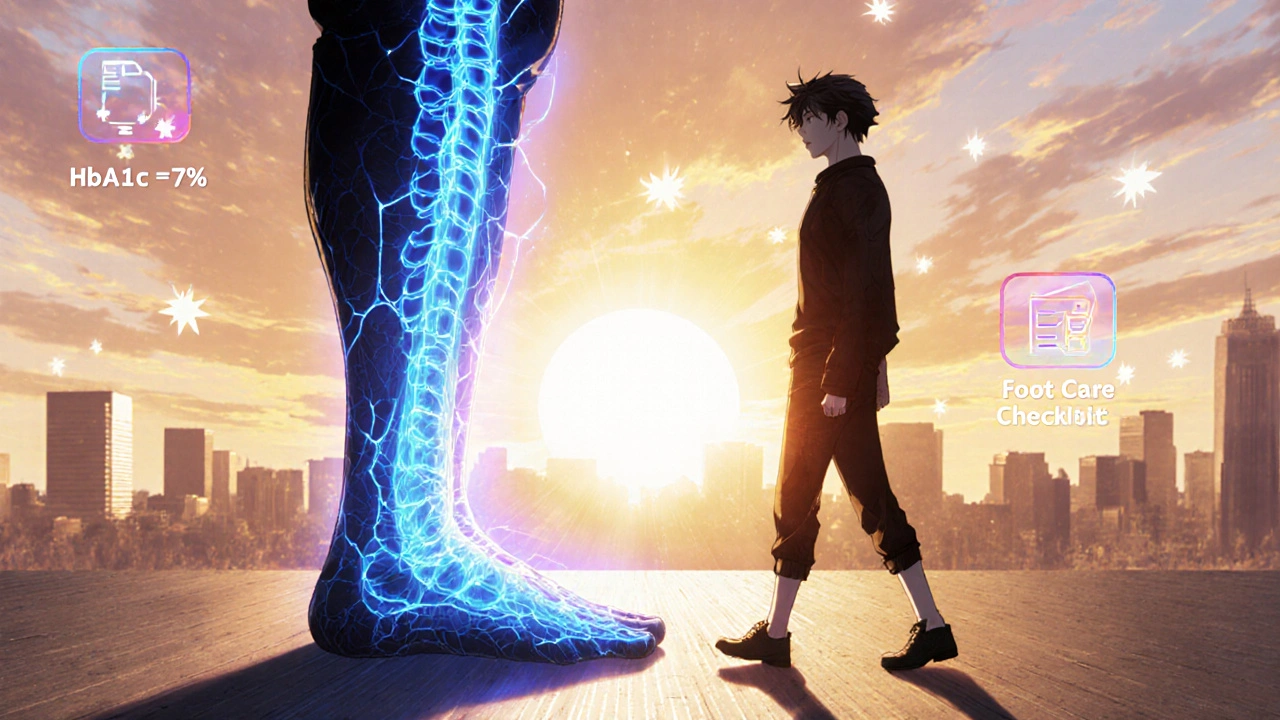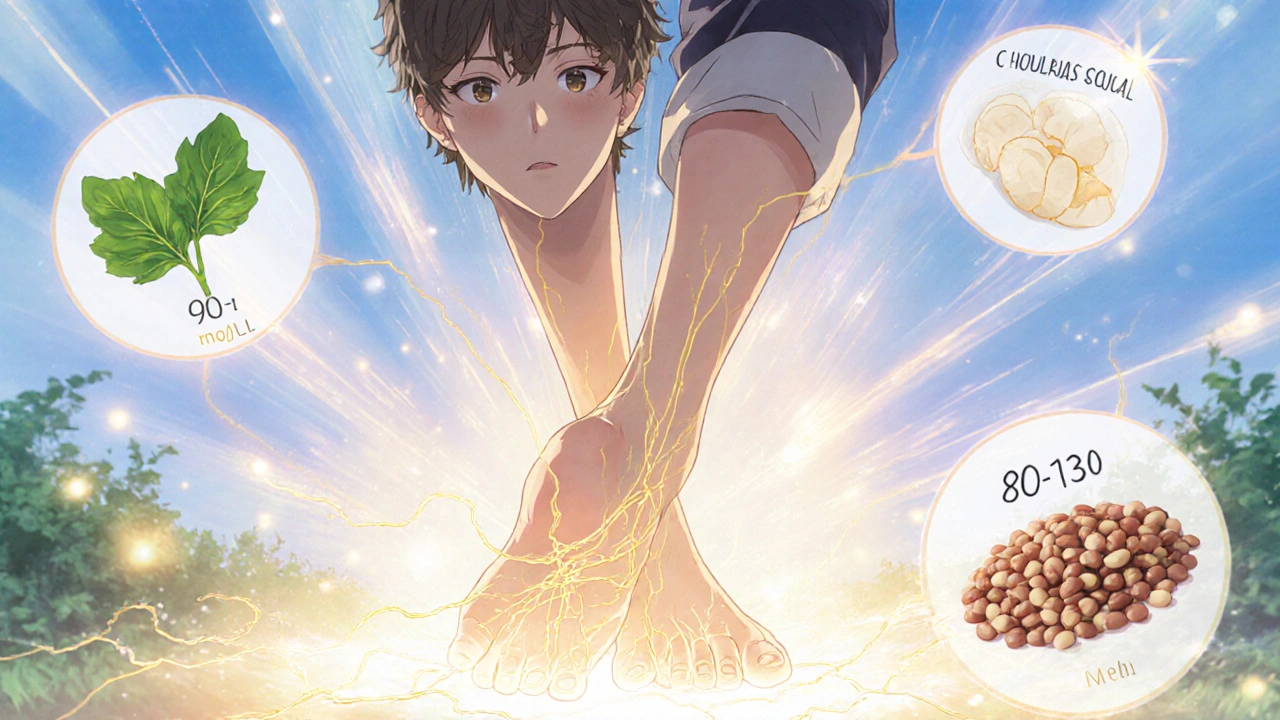Living with diabetes means more than watching your blood sugar. For up to 70% of people with diabetes, nerve damage called diabetic neuropathy quietly develops over time - often without warning. It starts with tingling in the toes, then numbness, then sharp, burning pain that won’t go away. By the time many people notice it, the nerves are already damaged. But here’s the truth: you can slow it down. You can reduce the pain. And in some cases, you can even bring back feeling you thought was gone for good.
Why Your Nerves Are Hurting
Diabetic neuropathy isn’t just a side effect - it’s a direct result of high blood sugar eating away at your nerves. Over years, excess glucose damages the tiny blood vessels that feed your nerves, especially in your feet and legs. Without proper oxygen and nutrients, nerves start to misfire. Some send pain signals when there’s no injury. Others go silent, leaving you unable to feel a cut or blister - which can turn into a serious infection. The most common type is diabetic peripheral neuropathy (DPN). It hits your feet first, then climbs up your legs. Later, it can affect your hands, arms, and even your digestive system, heart, and bladder. Painful diabetic neuropathy (PDN) affects 16-26% of people with diabetes. That’s more than 1 in 5. And if your HbA1c stays above 7%, your risk climbs fast.The Foundation: Blood Sugar Control
No pill, patch, or procedure works as well as keeping your blood sugar in range. The Diabetes Control and Complications Trial (DCCT) proved it: keeping HbA1c below 7% cuts your risk of nerve damage by 60%. That’s not a suggestion - it’s the single most powerful tool you have. Target fasting blood sugar: 80-130 mg/dL. Post-meal: under 180 mg/dL. Sounds simple, but it’s hard. Only 14% of people with diabetes hit these targets consistently. Why? Because it takes more than willpower. It takes a plan. Start with food. Cut out sugary drinks, white bread, and processed snacks. Eat more leafy greens, beans, whole grains, and lean protein. A 2023 study showed that people who switched to a low-glycemic diet saw a 0.8% drop in HbA1c in just 12 weeks - enough to slow nerve damage. Move every day. Walking 30 minutes after dinner lowers blood sugar better than any medication for many people. Swimming, cycling, or yoga work too. Exercise improves insulin sensitivity and helps nerves heal. Don’t wait until the pain fades to start - even mild movement helps.Medications That Actually Work
If pain is already here, you need more than diet and walking. Three medications are FDA-approved specifically for diabetic nerve pain: duloxetine, pregabalin, and amitriptyline.- Duloxetine (Cymbalta): A serotonin-norepinephrine reuptake inhibitor. In clinical trials, 35% of patients got at least 50% pain relief. Side effects? Nausea, dry mouth, dizziness. Not ideal for people with stomach issues.
- Pregabalin (Lyrica): An anticonvulsant that calms overactive nerves. Works for 30-40% of users. Common side effects: weight gain, drowsiness, swelling in hands or feet. Avoid if you have heart failure.
- Amitriptyline: An old-school tricyclic antidepressant. It’s cheaper and often more effective - 58-63% pain reduction in some studies. But it can cause drowsiness, dry mouth, and heart rhythm issues. Not for older adults or those with heart problems.
Topical Treatments: Less Systemic, More Local
If you hate pills or can’t tolerate side effects, try something that goes on your skin.- Capsaicin 8% patch (Qutenza): Made from chili pepper extract. Applied by a doctor once every 3 months. In trials, 40% of users got 30% pain reduction. No drowsiness. No weight gain. Just a brief burning sensation during application.
- Lidocaine 5% patches: These are available over the counter. Stick them on the most painful spots. They numb the area without affecting your whole body. Good for localized pain, like burning soles or tingling fingers.
Devices That Rewire Pain
Sometimes, pills and patches aren’t enough. That’s where devices come in.- TENS units: Small battery-powered devices that send gentle electrical pulses through your skin. In one study, 83% of users saw pain drop from 3.17 to 1.44 on a 5-point scale. You can buy these online. Use them 20-30 minutes a day, especially before bed.
- Peripheral Nerve Stimulation (PNS): A tiny wire is placed near the affected nerve. It sends pulses that block pain signals. Requires a minor procedure. Relief lasts months to years. Good for people who’ve tried everything else.
- Spinal Cord Stimulation: The newest and most promising. A small device is implanted near your spine. It doesn’t just mask pain - some patients report regained sensation in numb feet. A 2024 study showed 70% of long-term users had better balance and fewer falls. This isn’t science fiction anymore.
What Doesn’t Work - and Why
Many people try NSAIDs like ibuprofen for nerve pain. It doesn’t work. Nerve pain isn’t inflammation. It’s misfiring signals. Ibuprofen might help a sprained ankle, but not burning toes. And here’s the danger: long-term NSAID use raises your risk of heart attack and stroke by 10-20%. For someone with diabetes, that’s a bad trade-off. Your kidneys are already under stress. NSAIDs can make that worse. Alcohol? It kills nerves. Even moderate drinking speeds up neuropathy. Cut it out. And no, vitamin B12 supplements won’t fix it unless you’re actually deficient. Most people with diabetes aren’t. Don’t waste money on unproven “nerve repair” pills.
Lifestyle: The Hidden Game-Changer
Medications treat symptoms. Lifestyle fixes the cause.- Foot care: Check your feet every day. Use a mirror if you can’t see the bottom. Wash, dry, moisturize. No barefoot walking. Even a small cut can turn into an ulcer.
- Stress management: Chronic stress raises blood sugar. Try 10 minutes of deep breathing daily. Or walk in silence. Meditation apps like Insight Timer have free guided sessions for pain.
- Sleep: Poor sleep makes pain worse. Aim for 7-8 hours. If you’re tossing and turning, talk to your doctor about sleep apnea - it’s common in people with diabetes.
- Quit smoking: Smoking narrows blood vessels. That’s the last thing your damaged nerves need.
What to Expect - And When to Worry
Improvement takes time. Don’t expect pain to vanish overnight. Most people notice changes after 4-6 weeks of consistent treatment. If your pain gets worse, or you start losing muscle strength, or your feet feel colder - see your doctor. That could mean the damage is spreading. And if you’re feeling hopeless, depressed, or isolated - you’re not alone. One in four people with painful diabetic neuropathy develops depression. It’s not weakness. It’s a physical response to constant pain. Talk to someone. A counselor, a support group, your nurse educator - they’ve heard it all before.The Future Is Here
Research is moving fast. Drugs targeting Nav 1.7 sodium channels and N-type calcium channels are in late-stage trials. These could block pain signals without drowsiness or addiction. Nerve growth factor antibodies might actually repair damaged nerves. The American Diabetes Association predicts that within 5-10 years, we’ll have treatments that reverse nerve damage - not just mask it. Right now, you can’t wait for the future. But you can build it. By controlling your blood sugar. By choosing the right treatment. By moving your body. By caring for your feet. Your nerves can heal - if you give them a chance.Can diabetic neuropathy be reversed?
In early stages, yes - especially if blood sugar is tightly controlled. Studies show that with HbA1c below 7% for a year, some people regain feeling in their feet. But if nerves are severely damaged or you’ve had numbness for years, full recovery is unlikely. The goal shifts to stopping further damage and managing pain.
What’s the best painkiller for diabetic neuropathy?
There’s no single best option. Duloxetine and pregabalin are FDA-approved and work for many. Amitriptyline is often more effective but has more side effects. Capsaicin patches offer relief without systemic effects. The best choice depends on your health, other medications, and how your body reacts. Work with your doctor to find what works for you.
Can I use ibuprofen for diabetic nerve pain?
No. Ibuprofen and other NSAIDs don’t treat nerve pain. They target inflammation, but diabetic neuropathy is caused by nerve damage, not swelling. Worse, long-term use increases your risk of heart problems and kidney damage - both already higher in people with diabetes. Skip it.
How long does it take for nerve pain to improve?
It varies. Some notice relief from medications in 2-4 weeks. Topical treatments may take 1-2 weeks. Lifestyle changes like better blood sugar control can take 3-12 months to show results. Patience is key. Consistency matters more than speed.
Is exercise safe if my feet hurt?
Yes - but choose wisely. Avoid high-impact activities like running if you have numbness or open sores. Walking, swimming, cycling, and seated exercises are safe and effective. Always wear properly fitted shoes. Check your feet after every workout. Movement helps nerves heal - but only if you protect them.
What should I do if my pain gets worse?
Don’t wait. Contact your doctor immediately if pain increases, you lose strength in your legs, your feet feel colder, or you notice new sores or swelling. These could mean nerve damage is spreading or an infection is developing. Early action prevents amputations.
